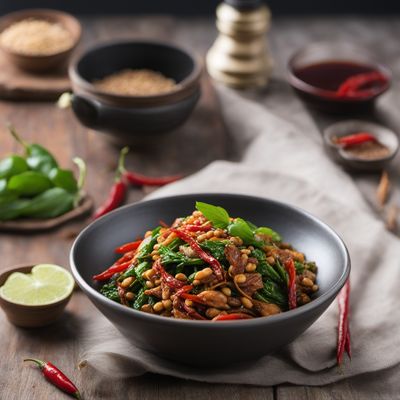
Ingredient
Lesser galangal roots
The Aromatic Spice
Lesser galangal roots, also known as Alpinia officinarum, are a rhizome belonging to the ginger family. They have a distinct spicy and peppery flavor with hints of citrus and pine. The roots are commonly used in Southeast Asian cuisines, especially Thai and Indonesian dishes, to add depth and complexity to curries, stir-fries, and soups. They have a fibrous and woody texture, which requires them to be finely sliced or grated before use.
Origins and history
Lesser galangal roots have been used in traditional medicine and culinary practices in Southeast Asia for centuries. They are native to Indonesia and are widely cultivated in Thailand, Malaysia, and other tropical regions. The roots are highly valued for their aromatic properties and are considered an essential ingredient in many traditional dishes.
Nutritional information
Lesser galangal roots are a good source of dietary fiber, vitamins, and minerals. They are low in calories and fat, making them a healthy addition to various dishes. However, it is important to note that the roots are typically used in small quantities due to their strong flavor.
Allergens
May cause allergic reactions in individuals with ginger or galangal allergies.
How to select
Choose lesser galangal roots that are firm, plump, and free from any soft spots or mold. The skin should be smooth and unblemished. Avoid roots that appear shriveled or dried out. If fresh roots are not available, dried or powdered lesser galangal can be used as a substitute, although the flavor may be slightly different.
Storage recommendations
Store fresh lesser galangal roots in the refrigerator, wrapped in a paper towel or plastic bag to prevent moisture loss. They can also be frozen for longer-term storage. Dried lesser galangal roots should be kept in an airtight container in a cool, dark place.
How to produce
Lesser galangal roots can be grown in tropical or subtropical regions with warm and humid climates. They require well-drained soil and partial shade. The roots can be propagated by dividing the rhizomes and planting them in suitable conditions. However, it is important to note that lesser galangal roots may take several years to mature and produce a harvestable crop.
Preparation tips
Before using lesser galangal roots, peel off the outer skin and finely slice or grate the inner flesh. The roots are typically added to dishes during the cooking process to infuse their flavor. They work well in curries, soups, stir-fries, and marinades. Lesser galangal roots can also be used to make a refreshing tea by steeping them in hot water.
Substitutions
Ginger root can be used as a substitute for lesser galangal roots, although the flavor will be slightly different. Alternatively, you can use a combination of ginger and black pepper to mimic the spicy and peppery notes of lesser galangal.
Culinary uses
Lesser galangal roots are commonly used in Thai and Indonesian cuisines. They are a key ingredient in dishes such as Tom Yum soup, green curry, and rendang. The roots can also be pickled or used to make traditional herbal remedies and beverages. Their aromatic and spicy flavor adds depth and complexity to a wide range of savory dishes.
Availability
Indonesia, Thailand, Malaysia
More ingredients from this category

Orris root
The Fragrant Rhizome of Elegance

Fingerrot roots
The Exotic Spice

Ginger roots
The Zesty Wonder: Unleashing the Power of Ginger Roots

East Indian galangal
The Exotic Spice of East India

Galangal roots
The Exotic Spice: Galangal Roots

Greater galangal roots
The Aromatic Spice: Unveiling the Secrets of Greater Galangal Roots

Wasabi roots
The Fiery Green Elixir: Unveiling the Secrets of Wasabi Roots
Recipes using Lesser galangal roots

Balinese-inspired Uštipci
Savory Balinese Delight: Uštipci with a Tropical Twist

Betawi-style Karjalanpaisti
Betawi Beef Stew: A Fusion of Finnish and Indonesian Flavors

Javanese-style Goma-ae
Savory Peanut Salad with a Javanese Twist

Nam Phrik Kha with Grilled Shrimp
Fiery Thai Chili Dip with Succulent Grilled Shrimp